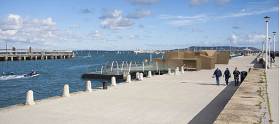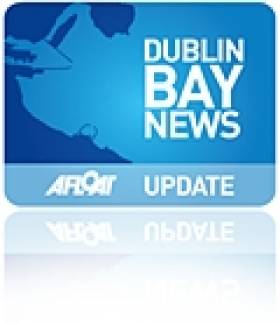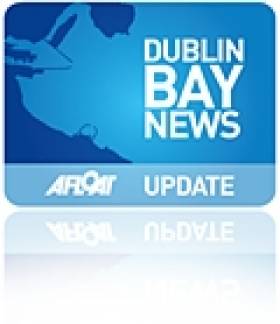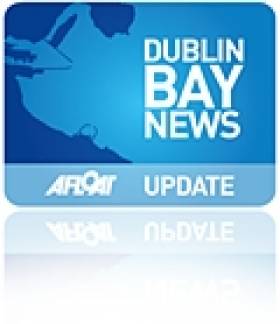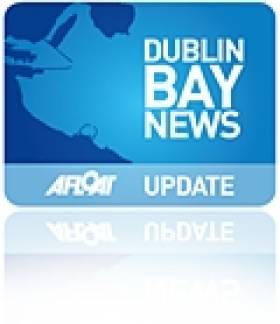Displaying items by tag: Urban Beach
Legal Tussle Over Contract For Dun Laoghaire ‘Urban Beach’
#UrbanBeach - A funding dispute over the proposed ‘urban beach’ development for Dun Laoghaire is going to the High Court.
According to Fora, Dun Laoghaire-Rathdown County Council (DLRCoCo) is taking legal action against the Dun Laoghaire Harbour Company to annul the contract between the two parties, alleging lack of progress on a project that was put on hold ‘pending organisational restructure’ in late 2016.
Modelled along the lines of Berlin’s Badeschiff, the development comprising an artificial beach and floating swimming pool barge along the East Pier has been stalled a number of times since first mooted as part of a series of regeneration plans for the harbour.
Up to €1.5 million of the €3 million costs of the project were expected to be funded by DLRCoCo, which has already reportedly paid thousands in arbitration fees over the dispute.
Ownership of the harbour company is supposed to transfer to the local authority, but a year ago county councillors expressed concern over the potential financial liabilities involved, as previously reported on Afloat.ie.
A risk assessment due later this month is expected to shed more light on the situation. Fora has more on the story HERE.
The €2.75 million urban beach proposed for Dun Laoghaire Harbour is 'currently on hold' pending 'organisational restructure', according to a report in the Irish Times. A spokesman for the state company told the newspaper 'we hope to have it back next year in planning next year for opening in 2018'.
Dun Laoghaire Harbour company is one of the joint funders of the project.
As Afloat.ie previously reported, the Dun Laoghaire project, that is modelled on Berlin's Badeschiff, has an artificial beach at the East Pier and a floating barge that contains a swimming pool.
It was orginally envisaged to have the swimming pool operational inside Dun Laoghaire harbour in April 2014.
The Dun Laoghaire 'Heated' Baths went out to tender in December 2012. In October 2013 DLRCoCo Applied for a Foreshore Consent for the Baths Refurbishment on the back of the East Pier and at Newtownsmith.
In the Irish Times article, author Justin Comiskey points to the idea that baths projects act as engines of renewal or to give underused urban spaces an identity. Read more here.
#urbanbeach – Dún Laoghaire Harbour Company hopes to be in a position to open a floating swimming pool and urban beach at the historic East Pier of the Harbour for the 2016 summer season.
Permission was granted in late-2014 by Dún Laoghaire Rathdown County Council, but had been appealed as Afloat.ie reported at the weekend.
The project has been inspired by the popular Badeschiff facility in Berlin, a floating swimming pool on the River Spree. The plan for Dún Laoghaire Harbour includes a floating swimming pool containing heated and treated seawater, utilising a converted river barge which will be located within the Harbour. The facility will include an Urban Beach alongside the floating structure, on Berth 1 adjacent to the East Pier. Changing and toilet facilities, a café, an administration area, and security features are also planned.
The Harbour Company estimates that urban beach has the potential to attract 100,000 visitors per year and to generate over €1 million per annum for the local economy.
Dún Laoghaire Harbour Company hopes to be in a position to open the facility for the summer season in 2016.
According to Tim Ryan, Operation Manager, of DLHC: "Today's go-ahead by An Bord Pleanála is very welcome, and marks a vital step in realising the full potential of the Harbour as a marine, leisure and tourist destination of international calibre."
"The urban beach will be a hugely exciting project for Dun Laoghaire as a while. It is very much in keeping with the Government's National Ports Policy which designated Dún Laoghaire as a harbour focusing on marine leisure, marine tourism, and urban development. Today's decision allows us to follow through on our mandate.
Over the coming months, Dún Laoghaire Harbour Company Harbour is set to welcome a record 100,000 cruise passengers and crew. "Combined with the news of the urban beach, the future for Dun Laoghaire Harbour is really shaping up, as set out in the Company's Masterplan of 2011," added Tim.
#DunLaoghaire - Dun Laoghaire's 'urban beach' proposal has finally been approved by An Bord Pleanála months after a last-minute appeal against the scheme.
Originally greenlit by planners late last year, the project – modelled after Berlin's famous Badeschiff – faced a fresh objection in the weeks after that approval, amid local concerns over potential damage to the East Pier where its set to be installed.
Charges for use of the facilities were also an issue, as The Irish Times reports, with People Before Profit councillor Melisa Halpin decrying Dun Laoghaire-Rathdown County Council's fast-tracking of such high-profile projects over smaller schemes "such as a path through a field".
The urban beach scheme, now costed at some €2.75 million, will be co-funded by the council and the Dun Laoghaire Harbour Company, which recently lost board member Pam Kearney over concerns regarding it and other "cornerstone projects" of the harbour's master-plan.
Dun Laoghaire 'Urban Beach' Faces Fresh Planning Objection
#DunLaoghaire - Despite getting the green light from planners six weeks ago, Dun Laoghaire's 'urban beach' project faces an appeal made against it to An Bórd Pleanála.
According to The Irish Times, councillors in Dun Laoghaire-Rathdown have been told of an appeal lodged in late December against the €2.5 million scheme modelled on Berlin's famous Badeschiff.
It has not been made known who made the appeal, though the original planning application received 15 objections during the public consultation from local groups and individuals.
Many of these expressed concern at potential damage to the protected East Pier where the Badeschiff would be installed, and also argued for council funds to be instead directed towards restoration of the derelict Victorian Baths nearby.
The Irish Times has more on the story HERE.
Dún Laoghaire Harbour Company Welcomes Planning Permission for Urban Beach Project
#urbanbeach – Dún Laoghaire Harbour Company (DLHC) has welcomed the award of planning permission for its proposal for a floating swimming pool and urban beach at the historic East Pier of the Harbour. Permission was granted by Dún Laoghaire Rathdown County Council in recent days.
The project has been inspired by the popular Badeschiff facility in Berlin, a floating swimming pool on the River Spree. The plan for Dún Laoghaire Harbour includes a floating swimming pool containing heated and treated seawater, utilising a converted river barge which will be located within the Harbour. The facility will include an Urban Beach alongside the floating structure, on Berth 1 adjacent to the East Pier. Changing and toilet facilities, a café, an administration area, and security features are also planned.
The Harbour Company estimates that urban beach has the potential to attract 140,000 visitors per annum and to generate over €1 million per annum for the local economy.
Dún Laoghaire Harbour Company hopes to be in a position to open the facility for the summer season in 2016.
According to Gerry Dunne, CEO of DLHC: "The granting of planning permission by Dún Laoghaire Rathdown County Council is very welcome, and marks a vital step in realising the full potential of the Harbour as a marine, leisure and tourist destination of international calibre."
"Further to extensive consultation, Dún Laoghaire Harbour Company published a very exciting Masterplan in 2011. The urban beach, coupled with plans for enhanced cruise berthing facilities and the development of a world-class diaspora centre, formed the corner-stone of this plan. The ambitions for the Harbour are very much in-keeping with the Government's National Ports Policy to designate Dún Laoghaire as a harbour focusing on marine leisure, marine tourism, and urban development. Therefore, we are delighted to receive planning permission for the beach allows us to follow through on our mandate."
In recent months, Dún Laoghaire Harbour Company has had great success in marketing the Harbour as a destination for cruise calls. In 2015, it is estimated that Dun Laoghaire will attract c100, 000 cruise passengers and crew. A planning application under the Strategic Infrastructure Development Act for a new cruise berth for 'next generation' cruise ship is expected to be submitted in the coming weeks to An Bord Pleanála
Dun Laoghaire 'Urban Beach' Greenlit By Planners
#DunLaoghaire - Plans for an 'urban beach' at Dun Laoghaire's waterfront first mooted more than a year ago have been given the green light by planning authorities, according to the Irish Independent.
As previously reported on Afloat.ie, the €2.5 million scheme is inspired by the Badeschiff in Berlin and will comprise and artificial beach with a floating heated swimming pool on a barge, with a café, changing areas and other facilities in temporary modular pods.
According to The Irish Times, it's expected that access to the East Pier beach – which will operate for six months each year – will cost the same as the average cinema ticket, generating as much as €1 million each year.
Locals who voiced opposition to the scheme in last year's public consultation hope that this money will go towards restoration of the derelict Victorian baths nearby.
To see photographs showing the proposed site in Dun Laoghaire, and photomontages of the initial conceptual design click HERE.
Dun Laoghaire Submits Planning Application For 'Urban Beach'
#DunLaoghaire - The Irish Times reports that a planning application has been lodged for the proposed 'urban beach' on Dun Laoghaire's waterfront.
The Dun Laoghaire Harbour Company submitted its application to An Bord Pleanála just before Christmas for the €2.5 million project, a joint venture with Dun Laoghaire-Rathdown County Council (DLRCC) inspired by the Badeschiff in Berlin.
Set to be constructed on berth 1 at the East Pier of Dun Laoghaire Harbour, the artificial beach will come with a floating, heated swimming pool built on a converted river barge, plus a cafe, changing area and other facilities.
As previously reported on Afloat.ie, the proposals were available for public consultation in September (click HERE to see an artist's impression of the completed project) and the final application will itself be open for submissions till 3 February 2014.
And it may only be the first of such 'urban beach' facilities for the South Dublin town, according to a local council member.
Independent councillor Victor Boyhan says DLRCC is still committed to its own plans to redevelop the derelict Victorian baths south-east of the East Pier that last operated as the Rainbow Rapids in the 1990s.
The Irish Times has more on the story HERE.
Dún Laoghaire ‘Urban Beach’ Artist impressions Published
#urbanbeach – Members of the public have five days left to share their views on a proposed new floating swimming pool and 'urban beach' facility for Dún Laoghaire Harbour. The facility is being developed by Dún Laoghaire Harbour Company as part of its long-term 'Masterplan' for the Harbour.
A consultation on the proposed new facility has been underway for the past month, and will close at 5pm on Friday, 27th September.
The plan for Dún Laoghaire Harbour includes a floating swimming pool containing heated and treated seawater, designed on a converted river barge which would be located on Berth 1 adjacent to the East Pier. The barge would also house an 'urban beach', and a second 'urban beach' would be located alongside the floating structure.
Today (20.09.13), Dún Laoghaire Harbour Company published artist impressions of the proposed facility. These are available to view at: www.dlharbour.ie/urbanbeach .
Commenting today, Tim Ryan, Operations Manager with DLHC, said: "We are the proud custodians of a beautiful, historic harbour, and it was important for us that the design of the proposed new floating swimming pool and urban beach reflects that."
"Our aim is to complement the existing attractions of the East Pier, and to draw inspiration from the Harbour's rich history. For example, the pod structures in the proposed new facility were inspired by the old-fashioned timber cargo crates, which would have been a common sight on the Piers when Dún Laoghaire was a more traditional shipping port. Each structure is single-storey and slightly dispersed to allow some visual penetration to the Harbour while ensuring privacy for bathers. Importantly, the floating pool will sit below pier level, and will therefore not detract from views of the Harbour from the East Pier.
"Changing and toilet facilities, a café, an administration area, and entrance and security features are also included in our initial plan. There is potential to have additional seating to the rear of the pod structures, as well as access to the café and toilet facilities both from the 'urban beach' side and from the Pier side."
It is anticipated that an entrance fee would be charged for the use of the urban beach and pool, and this is likely to be equivalent to the price of a cinema ticket. According to Dún Laoghaire Harbour Company, the proposed floating swimming pool and 'urban beach' has the potential to attract 140,000 visitors and to generate up to €1 million per annum for the local economy.
"Interested members of the public – including local residents and businesses, the sailing community, public representatives, and tourism organisations – have five days left to offer their views and recommendations on our proposals," said Tim Ryan. "We are hoping to submit a planning application before the end of 2013, with a view to having the new facility operational by the summer of 2015. In putting together our planning application, we will consider all views and feedback gathered during this public consultation process."
The floating swimming pool and urban beach project is being developed by Dún Laoghaire Harbour Company with support from Dún Laoghaire Rathdown County Council. The overall cost of the project is expected to be in the region of €2.5 million. Once operational, it is envisaged that the facility will be self-financing.
Submissions to the public consultation on the project can be made by post to: Urban Beach Design Team, Dún Laoghaire Harbour Company, Harbour Lodge, Crofton Road, Dún Laoghaire, or by email to [email protected].
Further information and frequently asked questions are available at www.dlharbour.ie/urbanbeach .
Urban Beach Public Consultation Launched for Dún Laoghaire Harbour
#dlhc – As Afloat.ie reported yesterday, Dún Laoghaire Harbour Company (DLHC) has today launched a public consultation on the development of a floating swimming pool and 'urban beach' alongside the renowned East Pier of Dún Laoghaire Harbour.
The proposed facility has the potential to attract 140,000 visitors and to generate up to €1 million per annum for the local economy, according to the Harbour Company.
The project has been inspired by the popular Badeschiff facility in Berlin, a floating swimming pool on the River Spree. The plan for Dún Laoghaire Harbour includes a floating swimming pool containing heated and treated seawater, designed on a converted river barge which will be located within the Harbour. The barge will also house an 'urban beach', and a second 'urban beach' will be located alongside the floating structure, on Berth 1 adjacent to the East Pier.
Changing and toilet facilities, a café, an administration area, and entrance and security features are also included in the Dún Laoghaire Harbour plan.
It is anticipated that an entrance fee will be charged for the use of the urban beach and pool, and this is likely to be equivalent to the price of a cinema ticket.
Speaking at the launch of the public consultation today, Tim Ryan, Operations Manager with DLHC, said: "The development of a floating swimming pool and urban beach is an exciting and innovative element of the Masterplan for Dún Laoghaire Harbour, which was published in 2011 after extensive consultation with the local community and other stakeholders. It is intended that the new facility will act as a significant public amenity and tourist attraction, and will create a hub of activity within the Harbour.
"A feasibility study for this project was conducted in 2012, and a project design team was appointed earlier this year. We are hoping to submit a planning application before the end of 2013, with a view to having the new facility operational by the summer of 2015. In putting together our planning application, we will consider all views and feedback gathered during this public consultation process."
The floating swimming pool and urban beach project is being developed by Dún Laoghaire Harbour Company with support from Dún Laoghaire Rathdown County Council. The overall cost of the project is expected to be in the region of €2.5 million. Once operational, it is envisaged that the facility will be self-financing.
"We are putting this project out to public consultation over the next four weeks so that all interested members of the public – including local residents and businesses, the sailing community, public representatives, and tourism organisations – can offer their views and recommendations on our proposals," said Tim Ryan. "The responses received from stakeholders will help inform the development of the project."
The consultation is open from now until Friday, 27th September 2013. Submissions can be made by post to: Urban Beach Design Team, Dún Laoghaire Harbour Company, Harbour Lodge, Crofton Road, Dún Laoghaire, or by email to [email protected].



























